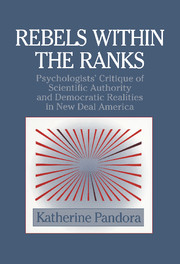 Rebels within the Ranks
Rebels within the Ranks Book contents
- Frontmatter
- Contents
- Acknowledgments
- Introduction
- 1 The Deep Context of Dissent: Jamesian Philosophy and Social Gospel Theology
- 2 Challenging the Rules of the Game
- 3 Defying the Law of Averages: Constructing a Science of Individuality
- 4 The Pursuit of “Impure” Science: Constructing a Science of Social Life
- 5 Natural History and Psychological Habitats
- 6 Exploratory Relativism and Patterns of Possibility
- Conclusions
- Notes
- Index
5 - Natural History and Psychological Habitats
Published online by Cambridge University Press: 06 October 2009
- Frontmatter
- Contents
- Acknowledgments
- Introduction
- 1 The Deep Context of Dissent: Jamesian Philosophy and Social Gospel Theology
- 2 Challenging the Rules of the Game
- 3 Defying the Law of Averages: Constructing a Science of Individuality
- 4 The Pursuit of “Impure” Science: Constructing a Science of Social Life
- 5 Natural History and Psychological Habitats
- 6 Exploratory Relativism and Patterns of Possibility
- Conclusions
- Notes
- Index
Summary
To get the feeling of what it is like to be a creature of the sea requires the active exercise of the imagination and the temporary abandonment of many human concepts and human yardsticks … Time measured by the clock or the calendar means nothing if you are a shore bird or a fish, but the succession of light and darkness and the ebb and flow of the tides mean the difference between the time to eat and the time to fast, between the time an enemy can find you easily and the time you are relatively safe. We cannot get the full flavor of marine life – cannot project ourselves vicariously into it – unless we make these adjustments in our thinking.
Rachel L. Carson (1941)In their concern with characterizing individuality and social context during the 1930s, Allport and the Murphys shared much with the techniques and goals of naturalists. Practices and values inherent in aspects of the American natural history tradition legitimated dissent from the mechanistic and reductionist values promoted by neobehaviorists, and also offered a scientific framework that carried powerful associations to such politically charged art forms in the 1930s as documentary film and literature. In drawing on the authority of natural history, and in appropriating some of its key constructs and practices, Allport and the Murphys were able to identify conditions under which it would be possible to display and investigate aspects of scientific “reality” that their orthodox colleagues asserted were incapable of “scientific” treatment.
- Type
- Chapter
- Information
- Rebels within the RanksPsychologists' Critique of Scientific Authority and Democratic Realities in New Deal America, pp. 119 - 151Publisher: Cambridge University PressPrint publication year: 1997


